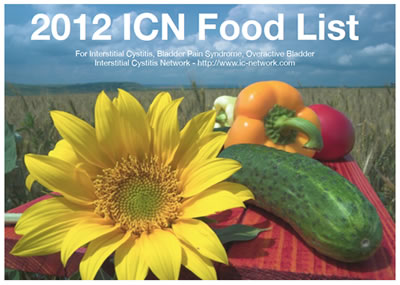Finding Bladder Friendly Foods
If you are newly diagnosed and your bladder symptoms are raging, you may be in so much discomfort that you simply can’t tell if foods irritate your bladder. Diet modification is a critical first step in gaining control over your symptoms. Ask yourself “would you pour coffee on an open wound on your hand?” The answer, of course, is “no.” Then how can you justify pouring acid on a wound in your bladder? It’s time to take charge of your diet to protect and soothe your bladder by following the IC Food Lists.
For the next three to six months, you should be modifying your diet to give your bladder wall an opportunity to calm down and, ideally, heal. One week or two weeks is not long enough. It takes weeks if not months for the bladder to have an opportunity to heal as well as for inflammation to be reduced. So, using the IC Food Lists for one or two weeks is simply not long enough. You’ll also need to do quite a bit of experimentation and perhaps even an elimination diet as you create your own, personalized food list.
Research Study Derived Lists
Start with the foods that research studies have determined to be either the “more bothersome” and “less bothersome” foods for IC patients. Table 1 includes the most bothersome foods which you should remove immediately from your diet. In Table 2, you will find foods which IC patients were generally able to enjoy without irritating their bladders provided, of course, that you don’t add risk foods to them (i.e. hot spicy sauces). Obviously, there are a lot of foods that are not covered by this list that you will find covered in the next list.
| The Most Bothersome Foods* | The Least Bothersome Foods* |
| Coffee – Regular & Decaf Tea – caffeinated Carbonated beverages – cola, non-colas, diet & caffeine-free Alcohols – Beer, Red Wine, White Wine, Champagne Fruits – Grapefruit, Lemon, Orange, Pineapple Fruit Juices – Cranberry, Grapefruit, Orange, Pineapple Vegetables – Tomato & Tomato Products Flavor Enhancers – Hot peppers, Spicy foods, Chili, Horseradish, Vinegar, Monosodium glutamate (MSG) Artificial Sweeteners – NutraSweet, Sweet ‘N Low, Equal (sweetener), Saccharin Ethnic foods – Mexican, Thai, Indian food |
Water Milk – low-fat & whole Fruits – Bananas, Blueberries, Honeydew melon, Pears, Raisins, Watermelon Vegetables – Broccoli, Brussels Sprouts, Cabbage, Carrots, Cauliflower, Celery, Cucumber, Mushrooms, Peas, Radishes, Squash, Zucchini, White potatoes, Sweet potatoes & yams Poultry – Chicken, Eggs, Turkey, Meat – Beef, Pork, Lamb Seafood – Shrimp, Tuna fish, Salmon Grains – Oat, Rice Snacks – Pretzels, Popcorn |
| *Friedlander J. et al. Diet and its role in interstitial cystitis/bladder pain syndrome (IC/BPS) and comorbid conditions. BJU International. BJU Int. 2012 Jan 11. | |
The ICN Food List
When you’re ready to expand your diet, the ICN Food List will help you choose foods that may be more bladder friendly. This diet list replaces old, outdated lists. The 2012 ICN Food list is the most current and combines information from patients and research studies into a comprehensive, alphabetized list of foods, offering bladder friendly, try it and caution variations of foods. A major goal of this document is to provide a list of foods for those patients who find themselves confused and/or afraid to eat. This new guide is a thirteen page document in printer friendly pdf format. To download your copy, please click the image below or the following link: https://www.ic-network.com/downloads/2012icnfoodlist.pdf

